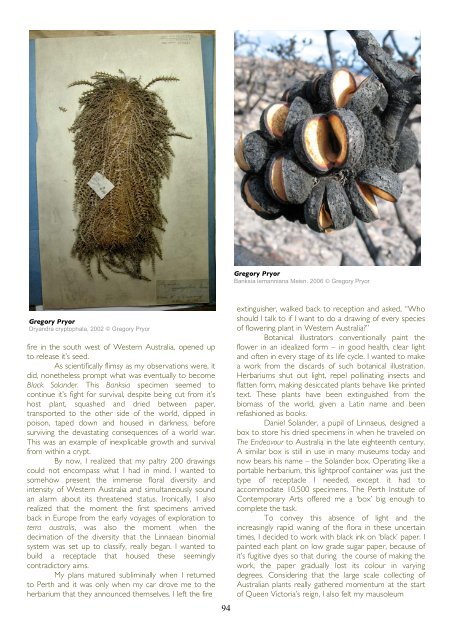M - Antennae The Journal of Nature in Visual Culture
M - Antennae The Journal of Nature in Visual Culture
M - Antennae The Journal of Nature in Visual Culture
You also want an ePaper? Increase the reach of your titles
YUMPU automatically turns print PDFs into web optimized ePapers that Google loves.
Gregory Pryor<br />
Dryandra cryptophala, 2002 � Gregory Pryor<br />
fire <strong>in</strong> the south west <strong>of</strong> Western Australia, opened up<br />
to release it’s seed.<br />
As scientifically flimsy as my observations were, it<br />
did, nonetheless prompt what was eventually to become<br />
Black Solander. This Banksia specimen seemed to<br />
cont<strong>in</strong>ue it’s fight for survival, despite be<strong>in</strong>g cut from it’s<br />
host plant, squashed and dried between paper,<br />
transported to the other side <strong>of</strong> the world, dipped <strong>in</strong><br />
poison, taped down and housed <strong>in</strong> darkness, before<br />
surviv<strong>in</strong>g the devastat<strong>in</strong>g consequences <strong>of</strong> a world war.<br />
This was an example <strong>of</strong> <strong>in</strong>explicable growth and survival<br />
from with<strong>in</strong> a crypt.<br />
By now, I realized that my paltry 200 draw<strong>in</strong>gs<br />
could not encompass what I had <strong>in</strong> m<strong>in</strong>d. I wanted to<br />
somehow present the immense floral diversity and<br />
<strong>in</strong>tensity <strong>of</strong> Western Australia and simultaneously sound<br />
an alarm about its threatened status. Ironically, I also<br />
realized that the moment the first specimens arrived<br />
back <strong>in</strong> Europe from the early voyages <strong>of</strong> exploration to<br />
terra australis, was also the moment when the<br />
decimation <strong>of</strong> the diversity that the L<strong>in</strong>naean b<strong>in</strong>omial<br />
system was set up to classify, really began. I wanted to<br />
build a receptacle that housed these seem<strong>in</strong>gly<br />
contradictory aims.<br />
My plans matured sublim<strong>in</strong>ally when I returned<br />
to Perth and it was only when my car drove me to the<br />
herbarium that they announced themselves. I left the fire<br />
94<br />
Gregory Pryor<br />
Banksia lemanniana Meisn. 2006 � Gregory Pryor<br />
ext<strong>in</strong>guisher, walked back to reception and asked, “Who<br />
should I talk to if I want to do a draw<strong>in</strong>g <strong>of</strong> every species<br />
<strong>of</strong> flower<strong>in</strong>g plant <strong>in</strong> Western Australia?”<br />
Botanical illustrators conventionally pa<strong>in</strong>t the<br />
flower <strong>in</strong> an idealized form – <strong>in</strong> good health, clear light<br />
and <strong>of</strong>ten <strong>in</strong> every stage <strong>of</strong> its life cycle. I wanted to make<br />
a work from the discards <strong>of</strong> such botanical illustration.<br />
Herbariums shut out light, repel poll<strong>in</strong>at<strong>in</strong>g <strong>in</strong>sects and<br />
flatten form, mak<strong>in</strong>g desiccated plants behave like pr<strong>in</strong>ted<br />
text. <strong>The</strong>se plants have been ext<strong>in</strong>guished from the<br />
biomass <strong>of</strong> the world, given a Lat<strong>in</strong> name and been<br />
refashioned as books.<br />
Daniel Solander, a pupil <strong>of</strong> L<strong>in</strong>naeus, designed a<br />
box to store his dried specimens <strong>in</strong> when he traveled on<br />
<strong>The</strong> Endeavour to Australia <strong>in</strong> the late eighteenth century.<br />
A similar box is still <strong>in</strong> use <strong>in</strong> many museums today and<br />
now bears his name – the Solander box. Operat<strong>in</strong>g like a<br />
portable herbarium, this lightpro<strong>of</strong> conta<strong>in</strong>er was just the<br />
type <strong>of</strong> receptacle I needed, except it had to<br />
accommodate 10,500 specimens. <strong>The</strong> Perth Institute <strong>of</strong><br />
Contemporary Arts <strong>of</strong>fered me a ‘box’ big enough to<br />
complete the task.<br />
To convey this absence <strong>of</strong> light and the<br />
<strong>in</strong>creas<strong>in</strong>gly rapid wan<strong>in</strong>g <strong>of</strong> the flora <strong>in</strong> these uncerta<strong>in</strong><br />
times, I decided to work with black <strong>in</strong>k on ‘black’ paper. I<br />
pa<strong>in</strong>ted each plant on low grade sugar paper, because <strong>of</strong><br />
it’s fugitive dyes so that dur<strong>in</strong>g the course <strong>of</strong> mak<strong>in</strong>g the<br />
work, the paper gradually lost its colour <strong>in</strong> vary<strong>in</strong>g<br />
degrees. Consider<strong>in</strong>g that the large scale collect<strong>in</strong>g <strong>of</strong><br />
Australian plants really gathered momentum at the start<br />
<strong>of</strong> Queen Victoria’s reign, I also felt my mausoleum












